SPECIAL REPORT
Bones of contention – fate of thousands of captive lions in SA depends on implementation of government report findings
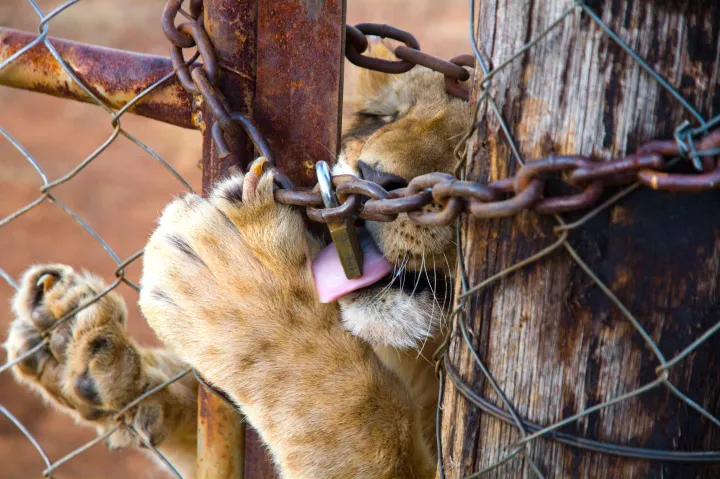
From 2008 to 2018, South Africa permitted the export of captive-bred lion skeletons. The well-being of a lion in captivity is irrelevant when all you want is its bones. This has led to enormous cruelty involving thousands of Africa’s most iconic animals.
Jabula was born at Predators Pride safari park in Hartbeespoort, North West.
When he was just a few weeks old, he was taken from his mother and moved to Chameleon Village, where he was monetised for cub petting. The story given to tourists and volunteers was that his mother had died and he needed to be hand-reared until he was ready to be returned to the wild.
This was a lie.
Eight months later, too big for petting, he returned to his birthplace to be used for tourist walks. There, a special bond formed between Jabula and his keeper, Armand Gerber. They would hug, and the lion would roll over for a tummy scratch.
But young lions grow into big, strong predators which become too dangerous to entertain tourists. At 18 months, Gerber discovered that Jabula was to be sent away. He began negotiations to buy the lion.
On 22 April, 2018, with the purchase still pending, a team from Wag ’n Bietjie farm near Bloemfontein arrived to collect Jabula despite Gerber’s protests. The men had shown no permits and no vet was present. Jabula was inexpertly darted and hauled away.
On 23 April, permission was granted for Gerber to buy Jabula.
He contacted Wag ’n Bietjie, but discovered the lion and his brother, Star, who had been removed earlier with 19 other lions, were being held in a small crate with no food or water.
Desperate, Gerber contacted the SPCA in Bloemfontein, asking them to investigate.
Inspector Reinet Meyer arrived at Wag ’n Bietjie on 24 April. Outside a farm shed she noticed a large pile of rotting meat covered in flies. On entering, she found a supervisor and about eight workers stripping the skin and flesh from the fresh carcasses of 26 lions, including Jabula and Star. Their flesh was being boiled away and they were reduced to clean skeletons.
That afternoon, a truck arrived with 28 more lions, which were to be killed the next day. They were darted by a vet and then shot through the ear with a low-calibre .22 rifle so as to not to damage their skulls.
“Overseas buyers don’t want a skull with a bullet in it,” the vet told her, which is why he didn’t shoot them directly in the cranium. More than 240 big cats were awaiting the same fate.
Meyer had stumbled on a lion slaughterhouse feeding an Asian demand for lion bones.
She filed charges and the police began investigating allegations of animal cruelty. It was known that South Africa was permitting the export of lion bones, but the scale of the slaughter was unprecedented.
Then the ducking and diving began.
According to Albi Modise of the Department of Environmental Affairs (DEA), the department could not comment on mass killings because, he said, the welfare of captive-bred lions fell under the mandate of the Department of Agriculture, Forestry and Fisheries (DAFF).
When approached, DAFF said the lions weren’t their responsibility either, but that of the Free State Department of Economic and Small Business Development, Tourism and Environmental Affairs (Destea).
According to Dirk Hagen of Destea, the primary responsibility for the lions’ welfare resided not with him, but with the SPCA and the owners of the animals.
Nobody was accepting responsibility for one of the world’s most shocking human betrayals of wildlife custodianship in a country that prided itself as a beacon of conservation.
Where did this grisly business begin, and why?
Pleasing the hunters
Hunting lions as trophies is expensive, tiring and not without danger.
But what serious hunter can consider their expedition to Africa a success without a snarling lion head to hang on their trophy wall?
In South Africa, a solution was in the making. Almost uniquely in the world, private citizens are permitted to own and breed wild animals. Given access to land, good fencing and a supply of meat – old horses and battery chickens are considered fine – lions are not difficult to breed.
There were and are many private reserves in the country where they’re kept, cared for and form part of private collections or tourist viewing.
But increasingly, game farmers began responding to opportunities presented by trophy hunters with few skills and deep pockets who were willing to bag a lion on a fly-in safari with no risks and a ready taxidermist.
Canned lion hunting was born.
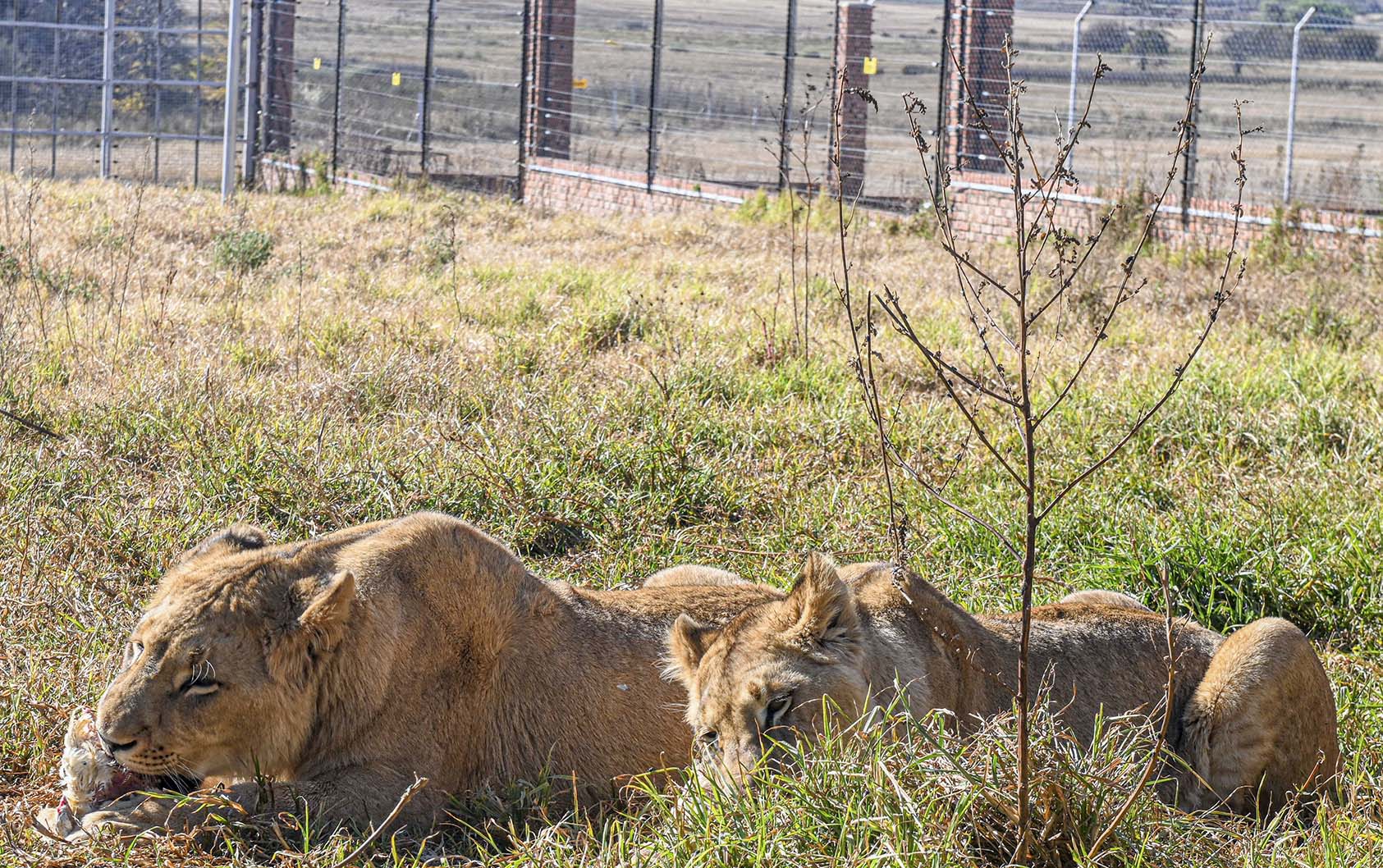
Lions at the Vrede Lion Farm on May 05, 2021 in Verkeerdevlei, South Africa. (Photo: Gallo Images / Volksblad / Mlungisi Louw)
In South Africa, the captive breeding of lions began in earnest in the 1990s, and by 1999 there were about 1,000 lions in the industry.
Today there are an estimated 366 facilities and between 8,000 and 12,000 captive lions providing relatively cheap lions for mostly foreign hunters.
Male lion shoots are said to be sold at between $25,000 and $40,000; females, half that. There could also be over 1,000 captive tigers.
Lion breeders have learned to profit from every stage of these lion’s lives. Wild female lions only give birth every 18 months to two years, but in captivity, cubs can be removed within days of being born, which brings the female into oestrus more quickly, allowing her to produce up to four litters every two years.
Income and labour is derived from “voluntourists” (often young foreigners in their gap year) who pay for the chance to hand-raise the cubs, while being told that “their” lions will be released into the wild. Later, adolescent lions are used to accompany awed tourists on walks.
The trade in illegal cubs in South Africa is also substantial, with prices ranging from $600 to $950 for a cub of one week to four months old, and $950 to $1,500 for a tiger cub, depending on the age, sex or subspecies.
Based on trade data focusing on live lions, trophies and skeletons explored in a FourPaws report, The Vicious Cycle, between 2008 and 2017 South Africa legally exported more than 16,000 lions and more than 400 tigers, dead or alive, with most sourced from captive populations.
CITES export permits issued in South Africa are consistently higher than the quantities recorded in importing countries. This is also true for tiger exports.
Because these lions are habituated, they have little fear of humans and are often inbred. Captive-bred lions have zero value to conservation or the estimated 3,000 wild lions in South Africa. Their existence is purely commercial.
In the North West province, where a large percentage of captive hunts take place, the shortest legal release time from captivity until the hunt is four days.
Opposition kicks in
Canned lion hunting first came to public notice when British filmmaker Roger Cook screened Making a Killing in May 1997. Using the cover story of being a hunting outfitter, and with hidden cameras, the team infiltrated the Lowveld hunting industry, filming the covert world of “tame” hunting.
“So-called canned hunting,” he explained, “involves unfairly preventing the target animal from escaping the hunter, thereby eliminating ‘fair chase’ and guaranteeing the hunter a trophy.
“The hapless animal is handicapped either by being confined to a small enclosure or because it has lost its fear of humans as a result of hand-rearing. Some are even tranquillised.”
They were told by professional hunter Kerth Boehme: “He [the client] just has to do a little bit, get the lion to the bait, make a half-hearted attempt to track the damn thing, or just shoot it from a blind [hide],” and that “even the weakest of clients can still be satisfied and still at least have done it, you know, semi-ethically”.
Then, in 2015, the documentary Blood Lions, anchored by environmentalist Ian Michler, followed, using the Cook Report’s technique of booking a hunt to penetrate the industry, revealing shocking conditions on breeding farms. The film fuelled the growing global antipathy toward lion hunting.
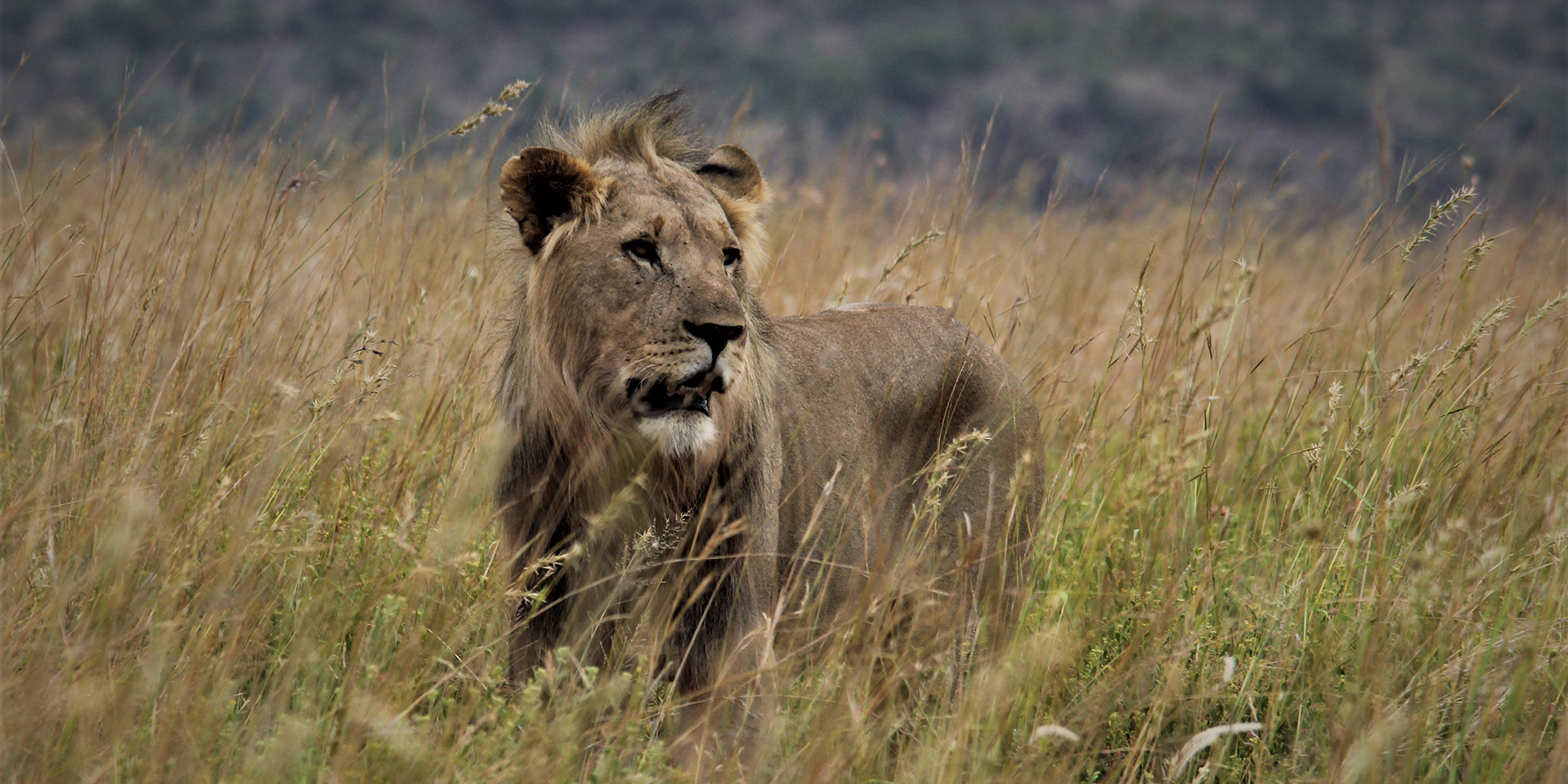
Lions are among the top five species exported as trophies from South Africa (Photo: Nel Botha / Pixabay)
Beyond South Africa’s borders, opposition to canned lion hunting was building.
Australia and France banned the import of trophies from captive lions and in late 2016, the US Fish and Wildlife Service under the Obama administration followed, saying the industry had not proved that it benefited the long-term survival of lions in the wild.
The European hunting community’s membership of South Africa’s main hunting associations (PHASA and CHASA) was revoked. Almost overnight, the industry lost more than half its hunting clients. Captive lion prices began dropping.
One of the world’s leading experts on lions, Dr Paul Funston, was quoted as saying: “It is confounding that a country whose iconic wild lions are such a source of national pride, not to mention tourist revenue, would take such risks as to sustain a marginal captive breeding industry that is condemned globally for its shameful practices.”
Selling bones
It was clear to lion breeders that canned hunting was heading for hard times – both because of local and international opposition.
But another avenue was already in place: the sale of lion skeletons to Asian buyers who were passing them off as tiger bones used in traditional medicine and “tiger bone wine” made from bones soaked in alcohol.
While hunted lions required a level of care and good feeding to attract clients, selling their bones necessitated no concern for their wellbeing when alive.
Lion bones had been exported from South Africa since 2008, but in 2017 the Department of Environment set a quota of 800 a year, raised it to 1,500 the following year, then brought it back to 800 after widespread NGO opposition.
Given the lack of capacity among South Africa’s law enforcement fraternity to check consignments at border posts, ports and airports, cheating on numbers and laundering of wild lions into consignments was inevitable, and the practice continues unabated.
A time of extreme cruelty to lions had arrived.
Unfortunately, bone sales were aided by a 2016 resolution taken at the 17th CITES Congress of Parties (COP17) which allowed South Africa to continue to trade in lion parts from captive lions, effectively creating a split-listing problem.
But on the grounds that separation was almost impossible to police, the resolution was used to justify the setting of bone export quotas into which wild lions and even tiger bones could be leaked.
Dr Kelly Marnewick, formerly senior trade officer for the Endangered Wildlife Trust’s Wildlife in Trade programme, warned that “poaching of wild lions for body parts has escalated in recent years and we cannot rule out a link to the market created for lion bones from captive breeding institutions”.
An explosive 2018 report by the EMS Foundation and Ban Animal Trading, titled, The Extinction Business: South Africa’s ‘Lion’ Bone Trade, found lack of verification in skeleton numbers and lack of due diligence by CITES authorities, with substantial loopholes in its permitting system.
As 91% of the skeletons that left the country in 2017 included skulls, “it can therefore be concluded, contrary to claims from government, that South Africa’s lion bone trade is not simply a by-product of the canned trophy hunting industry.
“Big cats are being commercially bred for their bones.”
Writing for the Organized Crime and Corruption Reporting Project (OCCRP), Khadija Sharife quoted SJ Alberts, who had spent more than 40 years working in the lion farming industry, who said: “I believe that the first mass euthanasia permits were issued around 2016. Some breeders saw the writing on the wall for the captive breeding industry. Suddenly the… value of thousands of animals existed only in their bones.”
In an attempt to increase profitability in captive breeding and the keeping of lions and other big cats, according to the Vicious Cycle report, when it comes to the lion bone trade, animal welfare is not a priority.
“A lack of adequate basic animal welfare conditions, such as sufficient water, food, shelter and medical care, is inevitable and a stark reality in South Africa.”
Bargaining with devils
Lion bones were leaving South Africa, but where were they going – and why?
According to export records at OR Tambo International Airport in Johannesburg, most were consigned to Laos. But according to customs records, none actually entered that country.
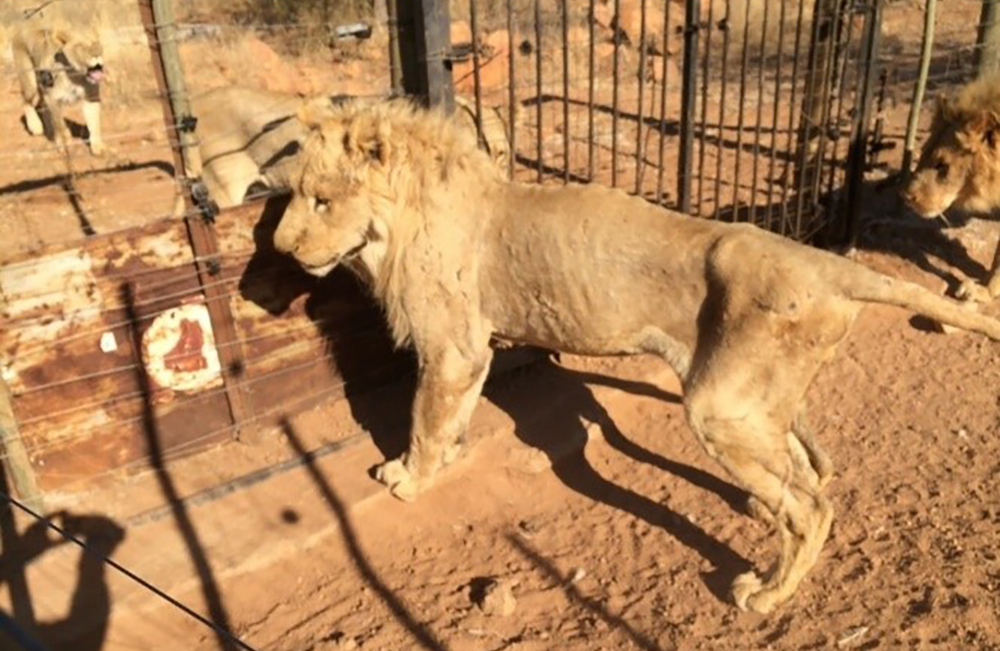
When bones are their only value, a lion’s condition is of no interest to breeders. Photo: Blood Lions archive
The OCCRP investigation found they were quietly being rerouted to neighbouring Vietnam. These volumes far exceeded the quota set in South Africa, with shipments either undervalued or stuffed with extra bones.
When its researcher tried to visit the top bone buyers in Laos — most of which are registered close to the home of Vexay Xaysavang, a man known as the “Pablo Escobar of wildlife trafficking” – they found no trace that the organisations even existed. They were shell companies, most linked to the Xaysavang Network.
According to The Extinction Business report, South Africa’s officially sanctioned quota of lion bones was in fact feeding a murky criminal underworld.
“It is widely accepted that trade on the Southeast Asian side is not transparent, properly understood or identified, and is associated with wild animal trafficking, poaching and the demise of tigers,” it said.
“Given this knowledge, this highlights a particularly worrying trend and literally means that governments on the supply and demand side, and the CITES Secretariat by implication, may be… aiding and abetting criminal activities.”
In 2017, a Guardian report by Nick Davies and Oliver Holmes noted that in a single year, 2014, Vinasakhone Trading was authorised by the Lao government to traffic $16.9m of animal products through Laos.
This included 20 tonnes of ivory valued at $5-million – a straightforward breach of international law. The quota also included 10 tonnes of lion bone and 1,300 tonnes of live turtles, snakes, lizards and pangolins, all of it in breach of CITES quotas.
They also reported that Vixay Keosavang had been granted permission to trade in 12 different species, including crocodiles, monkeys and pangolin anteaters, the skins of 100,000 pythons, 250 tonnes of soft-shelled turtles (which would mean killing about 45,000 of the animals), 100 tonnes of dogs, which are commonly cooked in Vietnamese restaurants, 1,000 magpies and 20 tonnes of animal bones, presumably lion.
The Extinction Business report warned that the link to organised crime should inform policy decisions around the legal trade.
The South African government, it said, was clearly placing the greed and profits of a marginal and problematic grouping before sound and ethical conservation management.
Who was this “marginal” grouping? It was a handful of brokers and taxidermists who have dominated the lion bone trade for years.
Sandra Linde Taxidermy exported more than 1,150 lion skeletons and carcasses between 2016 and 2019, making it the top bone trader during that period, and was named – following a question in Parliament – as supplying the Xaysavang Network.
Others supplying Xaysavang, according to The Extinction Business report, were Sebastian Rothmann, Manus Steyl and Kobus van der Westhuizen. Also exporting bones were JP Wapenaar, Hatari Taxidermy, GJ van Zyl and T Cloete.
Key farms supplying bones listed by forensic investigator Paul O’Sullivan were Shangwari Safaris, Seyl Game and Leeuwbosch Game Farm. Importers, all Lao-registered, were S. Durosagham, Sipharpra Duarseram, Vixay Keosovang, Jacek Raczka and Bounpasong Paphatsalang.
Keosavang’s role in widespread illegal wild animal trade had been noted by various law enforcement agencies in Asia from as early as 2003.
In 2013 the US government offered a $1-million reward for information leading to the dismantling of his organisation. Despite widespread knowledge that the Xasavang Network was a criminal syndicate, South Africa continued to permit the provision of CITES export permits.
The head of Asia Investigations for the Freeland Foundation, Steve Galster, noted, “Watching Vexay [Xasavang] operate for many years made me realise that the biggest threat to wildlife is the legal wildlife trade.”
Barbara Creecy moves the dial
Following the death of Jabula in 2018 and the discovery of the Wag ’n Bietjie and other lion abattoirs, major big cat conservation groups such as the Endangered Wildlife Trust, Panthera, the EMS Foundation, Ban Animal Trading, WildlifeACT, WildTrust, Blood Lions and the National Association of Conservancies called on South Africa’s then minister of environmental affairs, Dr Edna Molewa, to regulate the captive breeding carnivore industry to avoid welfare abuses.
The evidence in the Extinction Business investigation was hard to ignore.
It traced lion bones from the farm gate to consumers in Lao PDR, Vietnam and Thailand, its cover picture being of Jabula staring bleakly out of a barred cage shortly before his death. Slowly, official wheels began to turn in the right direction for beleaguered lions.
In 2015 the Environment Department had issued a Biodiversity Management Plan for lions which proposed a plan to ensure “viable and ecologically functional populations of managed and wild lions, along with well-managed captive populations”.
While still embracing captive breeding, it called for the establishment of a lion working group to plan the way forward.
Then, in August 2018, the Environment Department took the first steps towards regulation. A two-day colloquium on captive lion breeding was called by Parliament’s environmental committee.
Hearing views from scientists, economists, breeders, hunters and conservation NGOs, it concluded that captive lion breeding and canned hunting had done serious damage to South Africa’s international image and could show no conservation value.
Its chairman, Mohlopi Mapulane, said “we need to come up with a solution as quickly as we can as we can’t allow for our international reputation to be soiled”.
He added there was no scientific or conservation proof that the lion bone trade had any tourism advantage.
“Even the hunting organisations are turning their backs on the industry. We must do something as a country,” he said, and questioned how quotas for hunting and bone export were determined.
Key outcomes were:
- There is no conservation benefit to captive breeding of lions or the lion bone trade;
- The captive lion industry is damaging to South Africa’s image as a conservation leader and poses a substantial risk to our tourism industry;
- The use of lion bones and body parts and derivatives for traditional medicine is one of the major threats to wild lions and serves as a cover for illegally wild-sourced lion and other big cat parts;
- There’s a general abhorrence of the industry across multiple sectors including animal welfare, animal rights, conservation and hunting organisations which echo the South African public sentiment.
The National Assembly adopted the resolutions of the colloquium, which required the Department of Environmental Affairs – “as a matter of urgency” – to initiate policy and a legislative review of captive breeding of lions for the bone trade and submit quarterly reports to the portfolio committee on the progress.
The following year, new Environment Minister Barbara Creecy announced the formation of a High-Level Panel to “review the existing policies, legislation and practices related to the management, breeding, hunting, trade and handling of elephant, lion, leopard and rhinoceros”.
However, disappointingly, provincial authorities re-issued permits for 88 lion breeding facilities.
No time frame was set nor has legislation been amended so far, and the breeding industry is still legally allowed to continue its operations.
If lion breeders hoped for the quota of lion bones to be reopened, however, they were soon confronted by a ruling in August 2019 by Pretoria High Court Judge Jody Kollopen, who said it was inconceivable that the Department of Environmental Affairs could have ignored the welfare considerations of lions in setting the annual export quota of lion skeletons.
He found the DEA’s decision to set the quota for the exportation of 800 lion skeletons in June 2017, and 1,500 in 2018, had not followed due process and was unlawful and constitutionally invalid.
“Simply put, if as a country we have decided to engage in trade in lion bone, which appears to be the case for now, then at the very least, our constitutional and legal obligations… require the consideration of animal welfare issues.”
A few months later, following legal action taken against the DEA by the NSPCA, no quota was issued in 2019 and this zero quota has remained in place (though illegal sales continue).
However, while the Department of Environment’s High-Level Panel was grappling with wildlife welfare issues, another department, that of agriculture, was busy converting them to farm animals. While it administered the weak Animal Protection Act, it also had under its mandate the Animal Improvement Act and the Meat Safety Act.
In 2019 more than 30 wild animals, including lions, giraffes, white and black rhinos, lions and cheetahs were listed under the Animal Improvement Act, effectively rendering them farm animals subject to manipulation and consumption.
Shortly afterwards, 98 more wild animals were proposed to be listed under the Meat Safety Act, including rhinos, hippos, elephants and crocodiles.
According to the Act, they could then be “slaughtered for food for human and animal consumption”. At the time of writing, the effects of these reclassifications are unclear, but patently support the intensive farming of wild animals.
Visit Daily Maverick’s home page for more news, analysis and investigations
A 2020 report in the online peer-reviewed journal MDPI underlined the dangers of zoonic transfer of pathogens from such farming. It found 83 diseases and clinical symptoms in pathogens known to affect lions, which could cause harm to both animals and humans.
In 2021 Creecy released the 580-page High-Level Panel report which was then endorsed by Cabinet. It noted major contraventions in the breeding industry and signalled a powerful new dispensation for wild animals and appeared to mark the beginning of the end for captive lion breeding.
Its majority view was that “South Africa will not captive-breed lions, keep lions in captivity or use captive lions or their derivatives commercially.”
Its resolution over animal sentience and wellbeing put the Environment Department on a collision course with the Department of Agriculture, which has yet to be resolved.
Nearly 18 months later, none of the five specific recommendations of the High-Level Panel had been implemented. These were that the minister puts in place policy to halt:
- The sale of captive lion derivatives;
- hunting of captive-bred lions;
- tourist interactions with captive lions, and ensure
- a zero quota for lion derivatives and
- an immediate prohibition of trade and
- a prohibition of new breeding and sterilisation of lions to prevent it or immediate euthanasia.
In July the following year, Creecy gazetted a draft White Paper on the Conservation and Sustainable Use of South Africa’s Biodiversity. Its definition of sustainable use – one of the most progressive in the world – was a shot across the bows of those who used it as justification for wildlife farming and trophy hunting.
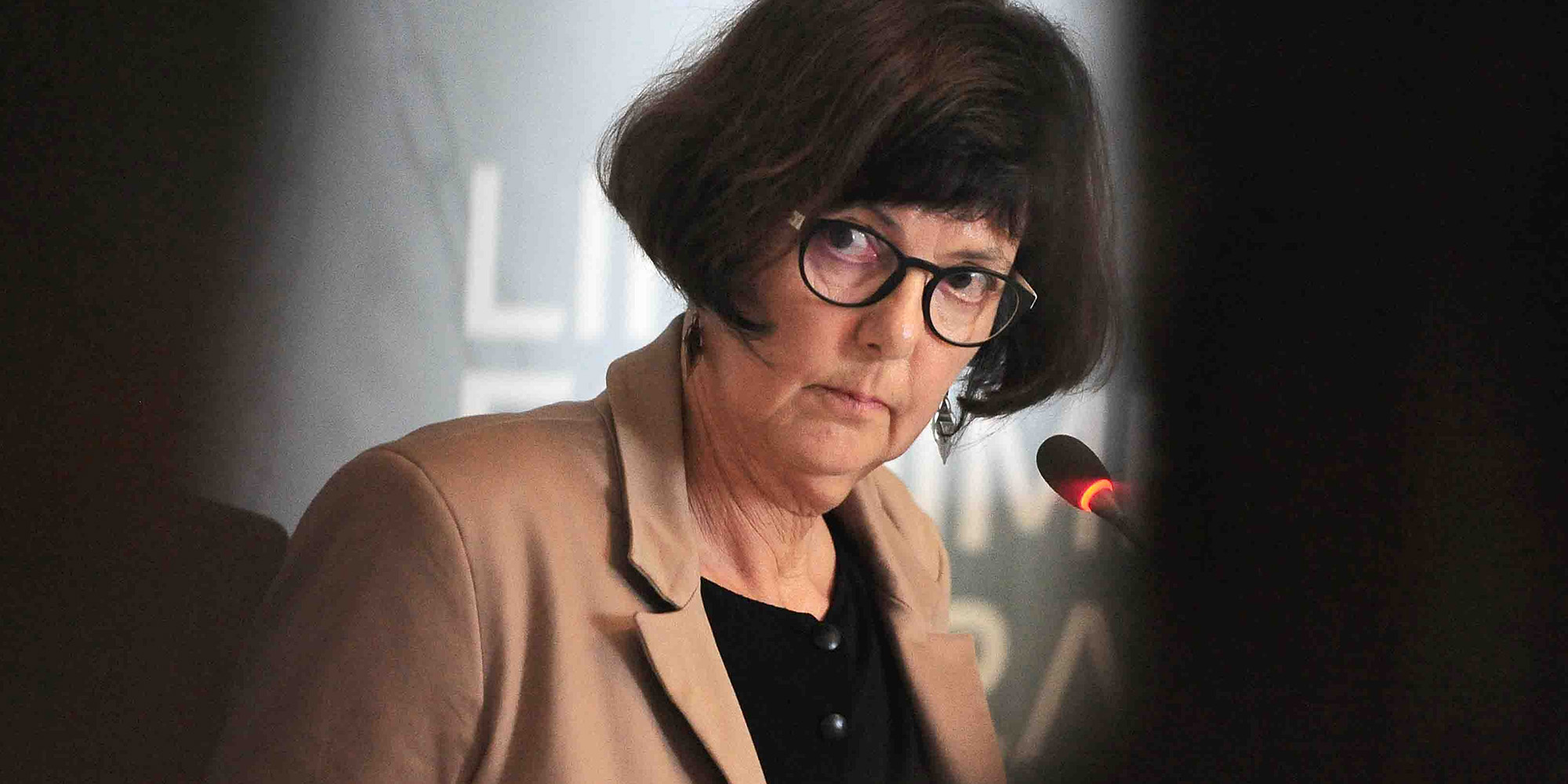
Minister of Forestry, Fisheries and the Environment Barbara Creecy. (Photo: Gallo Images / Sowetan / Thulani Mbele)
Species could only be “used” as long as the ecological integrity of the ecosystem in which they lived was not disrupted and their wellbeing was humane and not compromised.
Conditions under which an animal was kept had to be “conducive to its physical, psychological and mental health and quality of life, including its ability to cope with its life”.
In 2022 Creecy appointed a task team to recommend voluntary exit options and pathways for the captive lion industry. Its mission is to do an audit of all breeding facilities and plan the dismantling of the industry.
Read in Daily Maverick:
“Political parties agree — captive lion breeding must end”
“Claws out — catfight looms on lion breeder exit strategy”
Aware of the likelihood of endless litigation if captive lion breeding was banned outright, guidelines for the task team were to initially explore voluntary closure of facilities and disposal of lions. Carrot first, then, hopefully, the stick for non-compliance.
It will not be easy. A successful and responsible phase-out will face a number of management challenges.
Lion farming is governed by a patchwork of contrasting legislation across multiple provincial and national authorities with disparities and legal loopholes which create opportunities for harmful and fraudulent behaviour.
In the absence of a full national audit, the scope and scale of the commercial captive predator industry is largely unknown, and publicly available information is lacking.
Its findings are due to be presented by the end of June 2023.
The implementation of its findings could determine the fate of more than 10,000 lions, and will hopefully end a sad chapter in the exploitation of one of the world’s most magnificent animals. DM/OBP

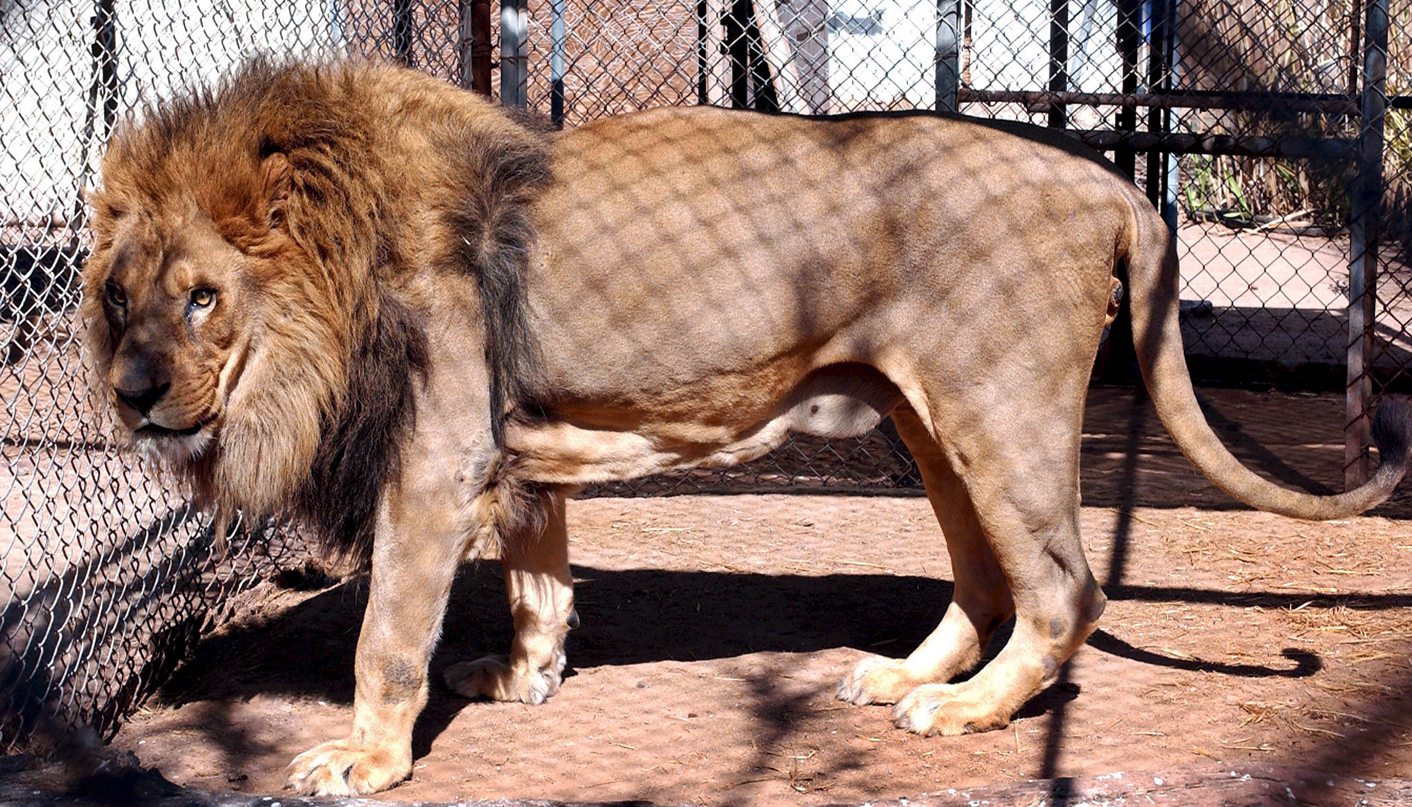
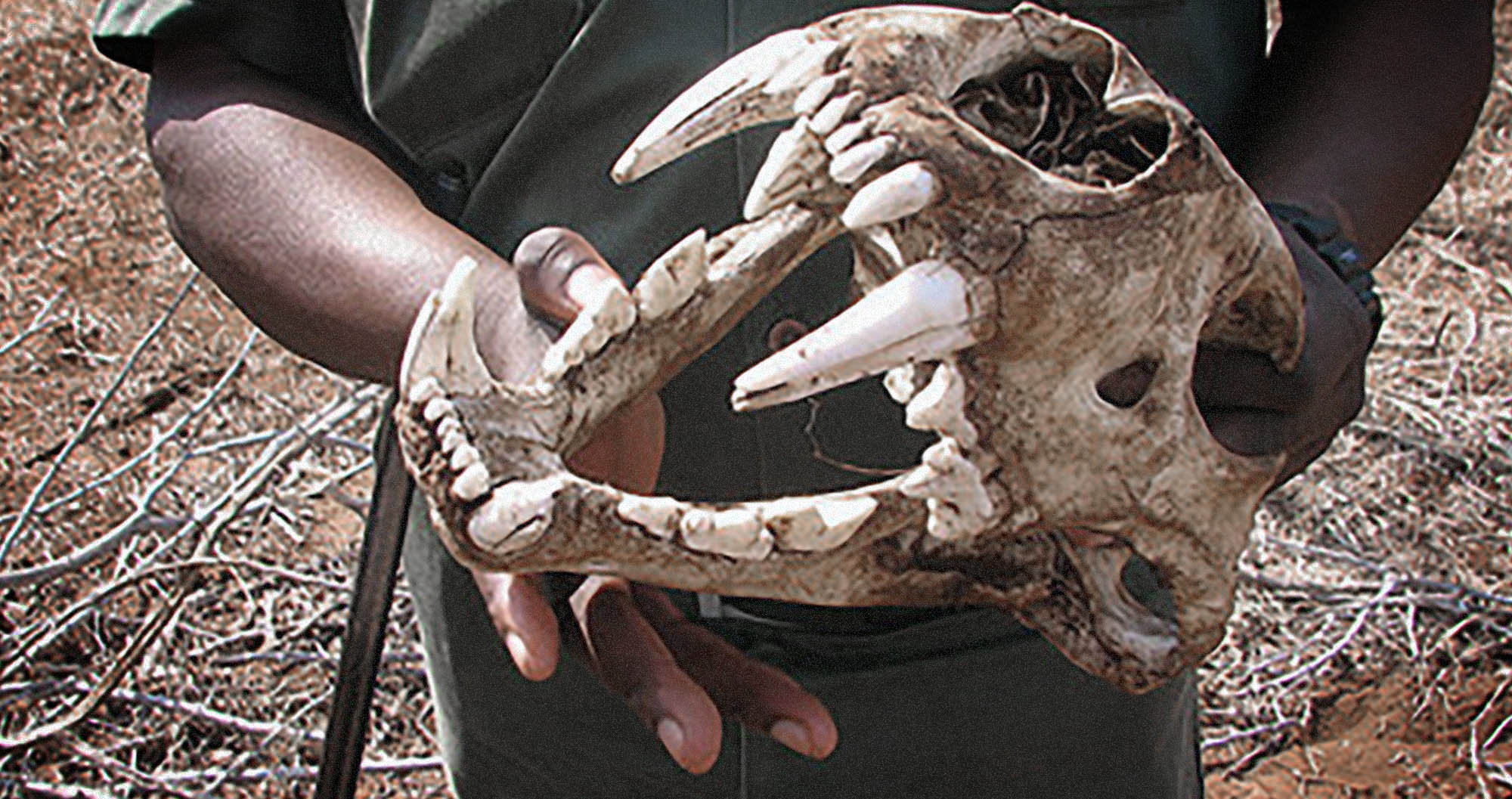










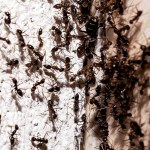










 Become an Insider
Become an Insider
I am sickened to the pit of my stomach. We have lost our humanity as a nation and as a government. We should all be outraged and force all involved government departments to make it a priority to halt this despicable trade immediately. Thanks DM for documenting this shameful story so thoroughly. Shout it from the rooftops please.
“The greatness of a nation and its moral progress can be judged by the way its animals are treated ” Mahatma Ghandi
No moral progress in this less than great nation.
Extremely upsetting story.